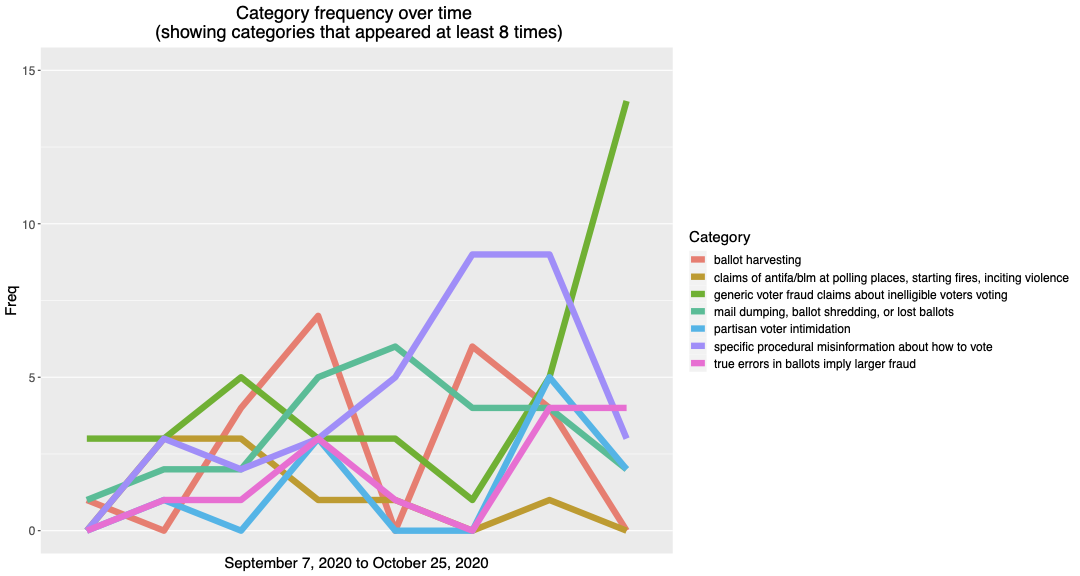EIP Weekly Update: Oct. 27
On 8:00am PT October 27th, the Election Integrity Partnership (EIP) hosted the third of four weekly public webinars to brief the public on the topics and trends of online election misinformation during the 2020 general election season. These briefings are held weekly at the same time through election day. Below is a brief summary of the presentation, the link to the full video of which can be found here.
Major Takeaways
From Oct. 20th to Oct. 27th, EIP actioned 52 unique election misinformation incidents, sourced from civil society partners, EIP researchers, election officials, and others.
Of the four categories of election-related misinformation, pre-delegitimization of the election results continued to be the most common misinformation topic encountered, with a decrease in misinformation about specific election procedures and an increase in narrative focus around “corrupt poll-workers.”
EIP researchers note that photo and video content, as well as emerging election-related court cases and decisions, are increasingly used as ‘evidence’ to support false or misleading narratives that serve to pre-delegitimize election results.
As the final day of voting approaches, platforms continue to develop their policies on election-related misinformation to adapt to a changing landscape of potential information operations.
Overview
The Election Integrity Partnership is a coalition of academic institutions that detect and analyze election-related misinformation surrounding the 2020 General Election. The goal of this work is to provide data-driven analysis and context around election misinformation to stakeholders in the public, private, and civil society sectors.
On September 8th, EIP began accepting tips from civil society partners as well as election officials through the EI-ISAC, and began monitoring major social media platforms for election-related misinformation. In that time, EIP analysts have responded to 257 unique incidents, including hundreds of pieces of content across the Internet.
Incidents by Topic
Of EIP’s four categories of election misinformation, as has been consistent throughout this election season, misinformation with the effect of pre-delegitimizing election results was the predominant trend. Additionally, EIP saw a decrease in specific procedural misinformation about how to vote and an increased focus on the ‘corrupt poll-worker’ narrative driven by videos taken extremely out of context.
Election mis- or disinformation category frequency over time
Reports Bulletin
Analysis of 10/21 Foreign Election Interference Announcement (10/23): EIP independently analyzes the disinformation content attributed to Iran, including voter intimidation emails claiming to be from the “Proud Boys” and a video alleging a compromise of voter data.
Narratives Targeting Electronic Voting Machines (10/21): EIP breaks down the past and present misinformation narratives across the political spectrum that have targeted the integrity of electronic voting machines.
“Friend-of-a-Friend” Stories as a Vehicle for Misinformation (10/26): EIP outlines a common trope for election misinformation: “friend-of-a-friend” stories. These are social media posts that claim to relay an unsubstantiated but salacious rumor, often encouraging others to copy/paste the story to spread it.
Uncertainty and Misinformation: What to Expect on Election Night and Days After (10/26): Senior EIP researchers describe the state of the information environment for this election season so far, using past trends and current observations to predict the state of the information environment on the last day of voting and afterwards. The key takeaways are as follows:
Democracy depends on trust in elections; that trust is under attack — both accidental and intentional. This will continue on Election Day and the days/weeks following.
The winner of many federal, state, and local elections will likely not be known on Election Day due to an increase in mail-in voting.
Uncertainty, anxiety, and potential red/blue or blue/red shifts will create opportunities for domestic and foreign political actors, conspiracy theorists, and other opportunists to delegitimize the election results.
There will be efforts to deter voting with images and videos of long lines, COVID-19 dangers, and protests.
The voting process (successes and failures) will be intensely documented, but the problems will be strategically framed and overemphasized to fit misleading narratives.
On the night of the election (and in the uncertain days that follow), premature winners will be declared, disenfranchisement will be highlighted, and “evidence” will be assembled to support false narratives of voter fraud. When they take action to address election-related misinformation, social media companies will be accused of censorship.
To support narratives seeking to delegitimize a shift in vote share from one party to another, lost and/or found post-election ballots will be problematized and politicized, affidavits will be filed, allegations of foreign interference will be made, and “bad statistics” will be selectively highlighted.
Advice to journalists and the public: prepare for uncertainty of results on election day/night, emphasize the vast majority of ballots and polling stations will experience no issues, highlight positive experiences of voting, know the conspiracies around shifts in vote shares, look to statements from election officials, and avoid sharing premature results from candidates or armchair data scientists.

